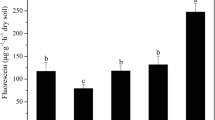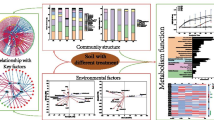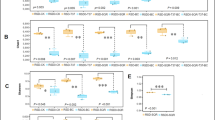Abstract
Reductive soil disinfestation (RSD) is an effective agricultural practice to eliminate soil-borne pathogens that heavily relies on the organic substrate used. However, the influences of combined application of organic residues on disinfestation efficiency, soil microbiomes, and their associated functional characteristics are still not well-characterized. In this work, four treatments, i.e., untreated soil (CK), RSD with 15 t ha−1 sugarcane bagasse (SB), bean dregs (BD), and their combinations (1:1, SB+BD), were conducted to investigate their influence on disinfestation efficiency, microbial functional diversity, community diversity, and composition using Biolog analysis, real-time PCR, and high-throughput sequencing. The SB+BD treatment had synergetic effects on soil microbial activity, metabolic activity, and functional diversity with similar efficacy in pathogen elimination and soil salinization alleviation, as compared to the SB and BD treatments. Moreover, the SB+BD treatment distinctly altered the structure and composition of bacterial and fungal communities, especially enriched the core microbiomes associated with soil general functions such as organic decomposition and nitrate removal. The SB+BD treatment also strengthened the soil specific functions including disease suppression through the regulation of unique microbiomes. In addition, the microbial richness, diversity, and evenness were significantly higher in the SB+BD-treated soil as compared to the SB- and BD-treated soils. Taken together, RSD incorporated with organic residue combination not only efficiently restore the degraded soils, but also considerably improve soil functions, which may benefit to the health for the future plant generations.
Key points
• Organic residue combination effectively declines pathogen density.
• Organic residue combination improves soil microbial activity and functional diversity.
• The enriched core microbiome is responsible for soil general functions.
• The induced unique microbiome is important for soil specific functions.






Similar content being viewed by others
References
Adam G, Duncan H (2001) Development of a sensitive and rapid method for the measurement of total microbial activity using fluorescein diacetate (FDA) in a range of soils. Soil Biol Biochem 33(7):943–951
Anderson T-H (2003) Microbial eco-physiological indicators to asses soil quality. Agric Ecosyst Environ 98(1):285–293
Blok WJ, Lamers JG, Termorshuizen AJ, Bollen GJ (2000) Control of soilborne plant pathogens by incorporating fresh organic amendments followed by tarping. Phytopathology 90(3):253–259
Bonanomi G, Antignani V, Capodilupo M, Scala F (2010) Identifying the characteristics of organic soil amendments that suppress soilborne plant diseases. Soil Biol Biochem 42(2):136–144
Butler D (2013) Fungus threatens top banana. Nature 504(7479):195–196
Butler DM, Kokalis-Burelle N, Muramoto J, Shennan C, McCollum TG, Rosskopf EN (2012a) Impact of anaerobic soil disinfestation combined with soil solarization on plant–parasitic nematodes and introduced inoculum of soilborne plant pathogens in raised-bed vegetable production. Crop Prot 39(8):33–40
Butler DM, Rosskopf EN, Kokalis-Burelle N, Albano JP, Muramoto J, Shennan C (2012b) Exploring warm-season cover crops as carbon sources for anaerobic soil disinfestation (ASD). Plant Soil 355(1-2):149–165
Caporaso JG, Kuczynski J, Stombaugh J, Bittinger K, Bushman FD, Costello EK, Fierer N, Pena AG, Goodrich JK, Gordon JI (2010) QIIME allows analysis of high-throughput community sequencing data. Nat Methods 7(5):335–336
Cavers PB (1995) Seed banks: memory in soil. Can J Soil Sci 75(1):11–13
Cebolla V, Busto J, Ferrer A, Miguel A, Maroto V (2000) Methyl bromide alternatives on horticultural crops. Acta Hortic 532:237–242
Coventry E, Noble R, Mead A, Whipps JM (2005) Suppression of Allium white rot (Sclerotium cepivorum) in different soils using vegetable wastes. Eur J Plant Pathol 111(2):101–112
Ebben MH, Gandy DG, Spencer DM (2010) Toxicity of methyl bromide to soil-borne fungi. Plant Pathol 32(4):429–433
Ebihara Y, Uematsu S, Nomiya S (2010) Control of Verticillium dahliae at a strawberry nursery by paddy-upland rotation. J Gen Plant Pathol 76(1):7–20
Edgar RC (2010) Search and clustering orders of magnitude faster than BLAST. Bioinformatics 26(19):2460–2461
Edgar RC, Haas BJ, Clemente JC, Quince C, Knight R (2011) UCHIME improves sensitivity and speed of chimera detection. Bioinformatics 27(16):2194–2200
Fisk MC, Ruether KF, Yavitt JB (2003) Microbial activity and functional composition among northern peatland ecosystems. Soil Biol Biochem 35(4):591–602
Garland JL (1996) Analytical approaches to the characterization of samples of microbial communities using patterns of potential C source utilization. Soil Biol Biochem 28(2):213–221
Garland JL, Mills AL (1991) Classification and characterization of heterotrophic microbial communities on the basis of patterns of community-level sole-carbon-source utilization. Appl Environ Microbiol 57(8):2351–2359
Gullino ML, Minuto A, Gilardi G, Garibaldi A, Ajwa H, Duafala T (2002) Efficacy of preplant soil fumigation with chloropicrin for tomato production in Italy. Crop Prot 21(9):741–749
Guo JH, Liu XJ, Zhang Y, Shen JL, Han WX, Zhang WF, Christie P, Goulding KWT, Vitousek PM, Zhang FS (2010) Significant acidification in major Chinese croplands. Science 327(5968):1008–1010
Hewavitharana SS, Ruddell D, Mazzola M (2014) Carbon source-dependent antifungal and nematicidal volatiles derived during anaerobic soil disinfestation. Eur J Plant Pathol 140(1):39–52
Huang G, Huang Y, Hu H, Liu F, Zhang Y, Deng R (2015a) Remediation of nitrate–nitrogen contaminated groundwater using a pilot-scale two-layer heterotrophic–autotrophic denitrification permeable reactive barrier with spongy iron/pine bark. Chemosphere 130:8–16
Huang X, Liu L, Wen T, Zhu R, Zhang J, Cai Z (2015b) Illumina MiSeq investigations on the changes of microbial community in the Fusarium oxysporum f. sp. cubense infected soil during and after reductive soil disinfestation. Microbiol Res 181:33–42
Huang X, Wen T, Zhang J, Meng L, Zhu T, Cai Z (2015c) Toxic organic acids produced in biological soil disinfestation mainly caused the suppression of Fusarium oxysporum f. sp. cubense. BioControl 60(1):113–124
Huang X, Wen T, Zhang J, Meng L, Zhu T, Liu L (2015d) Control of soil-borne pathogen Fusarium oxysporum by biological soil disinfestation with incorporation of various organic matters. Eu J Plant Pathol 143(2):223–235
Huang X, Liu L, Wen T, Zhang J, Wang F, Cai Z (2016) Changes in the soil microbial community after reductive soil disinfestation and cucumber seedling cultivation. Appl Microbiol Biotechnol 100(12):5581–5593
Huang X, Zhao J, Zhou X, Han Y, Zhang J, Cai Z (2019) How green alternatives to chemical pesticides are environmentally friendly and more efficient. Eur J Soil Sci 70(3):518–529
Kennedy AC, Smith KL (1995) Soil microbial diversity and the sustainability of agricultural soils. Plant Soil 170(1):75–86
Kõljalg U, Nilsson RH, Abarenkov K, Tedersoo L, Taylor AFS, Bahram M, Bates ST, Bruns TD, Bengtsson-Palme J, Callaghan TM (2013) Towards a unified paradigm for sequence-based identification of fungi. Mol Ecol 22(21):5271–5277
Kozich JJ, Westcott SL, Baxter NT, Highlander SK, Schloss PD (2013) Development of a dual-index sequencing strategy and curation pipeline for analyzing amplicon sequence data on the MiSeq Illumina sequencing platform. Appl Environ Microbiol 79(17):5112–5120
Li B, Li Q, Xu Z, Zhang N, Shen Q, Zhang R (2014) Responses of beneficial Bacillus amyloliquefaciens SQR9 to different soilborne fungal pathogens through the alteration of antifungal compounds production. Front Microbiol 5:636
Li R, Shen Z, Sun L, Zhang R, Fu L, Deng X, Shen Q (2016) Novel soil fumigation method for suppressing cucumber Fusarium wilt disease associated with soil microflora alterations. Appl Soil Ecol 101:28–36
Li Y, Wang B, Chang Y, Yang Y, Yao C, Huang X, Zhang J, Cai Z, Zhao J (2019) Reductive soil disinfestation effectively alleviates the replant failure of Sanqi ginseng through allelochemical degradation and pathogen suppression. Appl Microbiol Biotechnol 103(8):3581–3595
Liu F, Huang G, Fallowfield H, Guan H, Zhu L, Hu H (2013) Study on heterotrophic-autotrophic denitrification permeable reactive barriers (HAD PRBs) for in situ groundwater remediation. Springer, Heidelberg
Liu X, Zhang J, Gu T, Zhang W, Shen Q, Yin S, Qiu H (2014) Microbial community diversities and taxa abundances in soils along a seven-year gradient of potato monoculture using high throughput pyrosequencing approach. PLoS One 9(1):e86610
Liu L, Kong J, Cui H, Zhang J, Wang F, Cai Z, Huang X (2016) Relationships of decomposability and C/N ratio in different types of organic matter with suppression of Fusarium oxysporum and microbial communities during reductive soil disinfestation. Biol Control 101:103–113
Mazzola M, Granatstein DM, Elfving DC, Mullinix K (2001) Suppression of specific apple root pathogens by Brassica napus seed meal amendment regardless of glucosinolate content. Phytopathology 91(7):673–679
McDonald D, Price MN, Goodrich J, Nawrocki EP, DeSantis TZ, Probst A, Andersen GL, Knight R, Hugenholtz P (2012) An improved Greengenes taxonomy with explicit ranks for ecological and evolutionary analyses of bacteria and archaea. ISME J 6(3):610–618
Mendes R, Kruijt M, de Bruijn I, Dekkers E, van der Voort M, Schneider JHM, Piceno YM, DeSantis TZ, Andersen GL, Bakker PAHM, Raaijmakers JM (2011) Deciphering the rhizosphere microbiome for disease-suppressive bacteria. Science 332:1097–1100
Momma N, Kobara Y, Momma M (2011) Fe2+ and Mn2+, potential agents to induce suppression of Fusarium oxysporum for biological soil disinfestation. J Gen Plant Pathol 77(6):331–335
Momma N, Kobara Y, Uematsu S, Kita N, Shinmura A (2013) Development of biological soil disinfestations in Japan. Appl Microbiol Biotechnol 97(9):3801–3809
Neveinas M, Anned VD, Marcel W, Alexanderr VB, Jaapd J, Trudiegc C, Aadj T, Arienahc VB, Wimj B (2007) Biological Soil Disinfestation (BSD), a new control method for potato brown rot, caused by Ralstonia solanacearum race 3 biovar 2. Eur J Plant Pathol 117(4):403–415
Palaniyandi SA, Yang SH, Zhang L, Suh J-W (2013) Effects of actinobacteria on plant disease suppression and growth promotion. Appl Microbiol Biotechnol 97(22):9621–9636
Potin O, Rafin C, Veignie E (2004) Bioremediation of an aged polycyclic aromatic hydrocarbons (PAHs)-contaminated soil by filamentous fungi isolated from the soil. Int Biodeterior Biodegradation 54(1):45–52
Prosser JI (2002) Molecular and functional diversity in soil micro-organisms. Plant Soil 244(1/2):9–17
Shade A, Handelsman J (2012) Beyond the Venn diagram: the hunt for a core microbiome. Environ Microbiol 14(1):4–12
Shen Z, Ruan Y, Xue C, Zhong S, Li R, Shen Q (2015) Soils naturally suppressive to banana Fusarium wilt disease harbor unique bacterial communities. Plant Soil 393(1-2):21–33
Shennan C, Muramoto J, Koike ST, Daugovish O (2009) Optimizing anaerobic soil disinfestation for non-fumigated strawberry production in California. In: Obenauf GL (ed) Proceedings of the 16th Annual International Research Conference on Methyl Bromide Alternatives and Emissions Reductions. San Diego, CA. p. 23-1–23-4
Shennan C, Muramoto J, Koike S, Baird G, Fennimore S, Samtani J, Bolda M, Dara S, Daugovish O, Lazarovits G (2018) Anaerobic soil disinfestation is an alternative to soil fumigation for control of some soilborne pathogens in strawberry production. Plant Pathol 67:51–66
Shi WM, Yao J, Yan F (2009) Vegetable cultivation under greenhouse conditions leads to rapid accumulation of nutrients, acidification and salinity of soils and groundwater contamination in South-Eastern China. Nutr Cycl Agroecosyst 83(1):73–84
Shinmura A (2000) Causal agent and control of root rot of welsh onion. PSJ Soilborne Dis Workshop Rep 20:133–143
Shrestha U, Augé RM, Butler DM (2016) A meta-analysis of the impact of anaerobic soil disinfestation on pest suppression and yield of horticultural crops. Front Plant Sci 7:1254
Sonku Y, Kita K (1979) A study on disease control by water. VII. Effect of organic amendment and tarping on soil Eh and disease incidence of Fusarium wilt of tomato. Jap J Phytopathol 45:524–525
Szczech MM (1999) Suppressiveness of vermicompost against Fusarium wilt of tomato. J Phytopathol 147(3):155–161
Tilston EL, Pitt D, Groenhof AC (2002) Composted recycled organic matter suppresses soil-borne diseases of field crops. New Phytol 154(3):731–740
Uchida T, Asari S, Ashizawa T (1981) Control of tomato Verticillium wilt by rotation with paddy field. J Gen Plant Pathol 28-48
Ueki A, Kaku N, Ueki K (2018) Role of anaerobic bacteria in biological soil disinfestation for elimination of soil-borne plant pathogens in agriculture. Appl Microbiol Biotechnol 102(15):6309–6318
Wang Q, Garrity GM, Tiedje JM, Cole JR (2007) Naive Bayesian classifier for rapid assignment of rRNA sequences into the new bacterial taxonomy. Appl Environ Microbiol 73(16):5261–5267
Watanabe B (1973) Effect of flooding on Rhizoctonia solani. Jap J Phytopathol 39:200
Wei Z, Yang X, Yin S, Shen Q, Ran W, Xu Y (2011) Efficacy of Bacillus-fortified organic fertiliser in controlling bacterial wilt of tomato in the field. Appl Soil Ecol 48(2):152–159
Wen T, Huang X, Zhang J, Cai Z (2016) Effects of biological soil disinfestation and water regime on suppressing Artemisia selengensis root rot pathogens. J Soils Sediments 16(1):215–225
Xiong W, Li R, Ren Y, Liu C, Zhao Q, Wu H, Jousset A, Shen Q (2017) Distinct roles for soil fungal and bacterial communities associated with the suppression of vanilla Fusarium wilt disease. Soil Biol Biochem 107:198–207
Xun W, Huang T, Zhao J, Ran W, Wang B, Shen Q, Zhang R (2015) Environmental conditions rather than microbial inoculum composition determine the bacterial composition, microbial biomass and enzymatic activity of reconstructed soil microbial communities. Soil Biol Biochem 90:10–18
Zhao J, Ni T, Li Y, Xiong W, Ran W, Shen B, Shen Q, Zhang R (2014) Responses of bacterial communities in arable soils in a rice-wheat cropping system to different fertilizer regimes and sampling times. PLoS One 9(1):e85301
Zhao J, Ni T, Li J, Lu Q, Fang Z, Huang Q, Zhang R, Li R, Shen B, Shen Q (2016) Effects of organic–inorganic compound fertilizer with reduced chemical fertilizer application on crop yields, soil biological activity and bacterial community structure in a rice–wheat cropping system. Appl Soil Ecol 99:1–12
Zhao J, Mei Z, Zhang X, Xue C, Zhang C, Ma T, Zhang S (2017) Suppression of Fusarium wilt of cucumber by ammonia gas fumigation via reduction of Fusarium population in the field. Sci Rep 7:43103
Zhao J, Zhou X, Jiang A, Fan J, Lan T, Zhang J, Cai Z (2018) Distinct impacts of reductive soil disinfestation and chemical soil disinfestation on soil fungal communities and memberships. Appl Microbiol Biotechnol 102(17):7623–7634
Funding
This study was financially supported by the National Natural Science Foundation of China (41701277, 41977032), the National Key Research and Development Program of China (2017YFD0200600), the China Postdoctoral Science Foundation (2018M630573, 2019T120442), the Startup Funds of Nanjing Normal University (184080H202B136), and the Priority Academic Program Development (PAPD) of Jiangsu Higher Education Institutions and the Key Subjects of Jiangsu Province (Ecology).
Author information
Authors and Affiliations
Contributions
JZ, XQH, JBZ, and ZCC conceived and designed research. JZ, SZL, XZ, QX, XL, and SRZ conducted experiments. JZ and XZ analyzed data. JZ wrote the manuscript. All authors read and approved the manuscript.
Corresponding author
Ethics declarations
Conflict of interest
The authors declare they have no conflict of interest.
Ethical approval
This article does not contain any studies with human participants or animals performed by any of the authors.
Additional information
Publisher’s note
Springer Nature remains neutral with regard to jurisdictional claims in published maps and institutional affiliations.
Electronic supplementary materials
ESM 1
(PDF 826 kb)
Rights and permissions
About this article
Cite this article
Zhao, J., Liu, S., Zhou, X. et al. Reductive soil disinfestation incorporated with organic residue combination significantly improves soil microbial activity and functional diversity than sole residue incorporation. Appl Microbiol Biotechnol 104, 7573–7588 (2020). https://doi.org/10.1007/s00253-020-10778-7
Received:
Revised:
Accepted:
Published:
Issue Date:
DOI: https://doi.org/10.1007/s00253-020-10778-7




